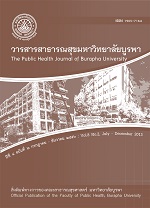Application of Geographic Information System (GIS) for determining the distribution of iodine concentration inwater, soil and vegetables in a Northeast Village
Main Article Content
บทคัดย่อ
This survey research was aimed to investigate the sources of iodine concentration in water, topsoil and local vegetables by applying Geographic Information System (GIS) at Ban Nong Koo, Nongpling Sub-district, Muang District, Mahasarakham Province. The concentration of iodine was analyzed with Sandell-Kolthoff reaction using Moxon and Dixon Method from 200 randomly selected specimens taken from natural water source, topsoil and local vegetables. Descriptive statistics such frequency, percentage, mean, median, and standard deviation was used for data analysis. The results revealed that 40 % had rain water for domestic use and 90% had rain water for consumption. Soil morphology and texture was Loamy-Sandy (42%) and Gray-Darkgray Loamy-Sandy (42%). The villagers cultivated mostly herb (40.0%). Average water iodine concentration in domestic use water was 61.54 μg/l. Rain water had the highest average concentration of iodine (69.23 μg/l), and rain water for consumption had the average concentration of 71.25 μg/l. Average soil iodine concentration was 43.95 μg/100g, of which clay was the highest. Iodine concentration in vegetables ranged from 2.67 to 45.90 μg/100g with an average of 20.45 μg/100g. The highest iodine concentration in vegetables was found in hairy basil (Ocimum basilicum L.f. var. citratum Back.), followed by green shallot (Alliumcepa var. aggregatum), tomato (Lycopersicon esculentum Mill.), and white popinac (Leucaena leucocephala Lamk. de Wit), respectively. GIS application revealed that iodine concentration in drinking water was 40.01-60.00 μg/l, and was 50.01-65.00 μg/l in domestic use, 40.01-50.0 μg/100g in soil, and 15.01-20.00 μg/100g in vegetables. The results of this study demonstrated that GIS application could illustrate a more vivid distribution of iodine concentration in natural sources. Iodine deficient areas could be identified, and used as the data source for iodine deficiency prevention program by future supplementation of iodine in the food chain.
Article Details
รูปแบบการอ้างอิง
Yangyuen, S., Somdee, T., & Mahaweerawat, U. (2014). Application of Geographic Information System (GIS) for determining the distribution of iodine concentration inwater, soil and vegetables in a Northeast Village. วารสารสาธารณสุข มหาวิทยาลัยบูรพา, 8(2), 1–15. สืบค้น จาก https://he02.tci-thaijo.org/index.php/phjbuu/article/view/45558
ประเภทบทความ
Original Articles

